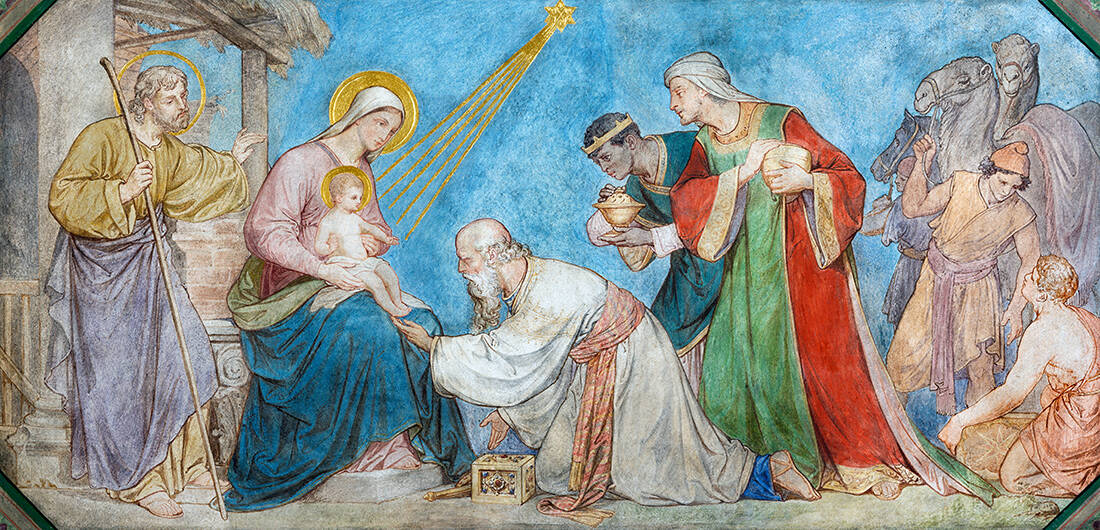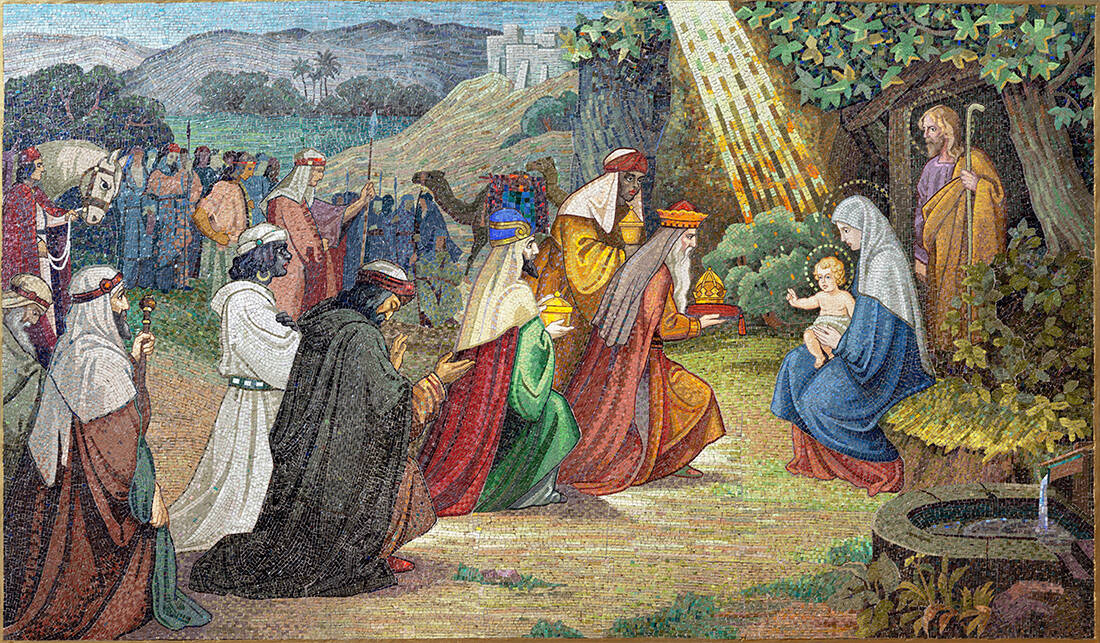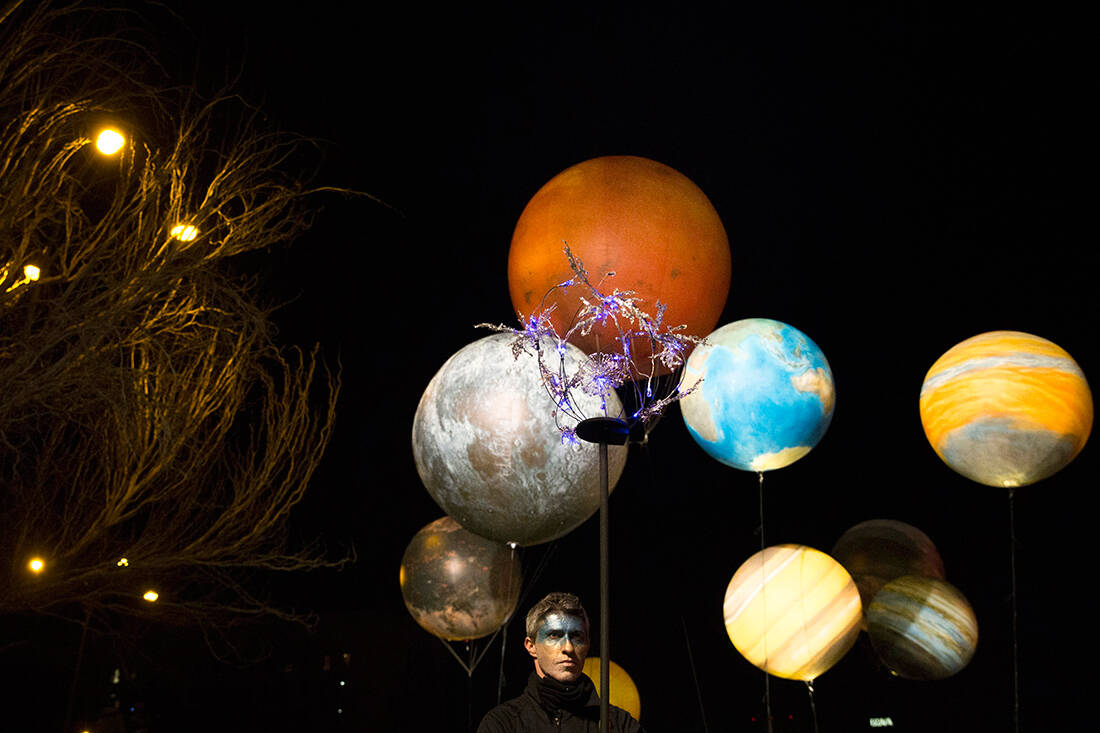The Adoration of the Magi is one of the most beautiful Christmas stories, a wonderful biblical narrative that left us a legacy of all these stars with which we decorate the Christmas.
And the star of the tree itself of course, which traditionally sits on top of the fir tree.
Although the Star of Bethlehem is mentioned only by the evangelist Matthew, it has managed to become one of the most timeless symbols of Christmas.
Its impact far surpassed the Christian world, being a story that everyone has known for centuries.

And yet, for astronomers, it remains an unsolved mystery, a mystery that has been debated for 2.000 years.
What was it that inspired Matthew to tell us about it? star who showed the way to the three magicians?

According to Matthew, whose gospel is the only one of the four of the Canon which mentions magicians, the enlightened and eminent personalities whom he calls "magicians" came from the depths of the East to worship the king of the Jews.
The Evangelist writes (2: 1-2): εἴδομεν γὰρ αὐτοῦ τὸν ἀστέρα ἐν τῇ ἀνατολῇ καὶ ἤλθομεν προσκυνῆσαι αὐτῷ ».
Melchior, Gaspar and Balthasar followed the Star of Bethlehem to reach the Jerusalem. There they consulted the inhabitants and after their meeting with Herod, Matthew affirms (2: 9) that "those who did not listen to the king went away; ».
The star reappeared to lead them straight to Bethlehem. And the magicians "ἰδόντες δὲ τὸν ἀστέρα ἐχάρησαν χαρὰν μεγάλην σφόδρα" (2:10), as the star was not wrong.

These few things Matthew tells us about the bright star that the three wise men had on their long journey. And the truth is that the event troubled the Christian church from the first moment.
The great hierarch and theologian John Chrysostom, apparently realizing the problem of the Star of Bethlehem, attributed it to a miracle. Theologically speaking, he tells us, it was a divine omen for announcing the incarnation of the Son of God.
Saint Chrysostom thinks that he was not a natural star, as one would think, but an invisible, miraculous logical force ("I transformed the invisible into this Ipsin").
The same metaphysical interpretation was given by Origen, a significant ecclesiastical figure of the early Christian years. The Star of Bethlehem in its own reasoning was nothing but the fulfillment of a prophecy mentioned in the Old Testament ("Numbers") and associated with the coming of the Messiah.

If we assume that the Star of Bethlehem was not a fictional story but a real celestial object, as a portion of the astronomy world has speculated, then we have to make some preliminary assumptions.
As astronomer Larry Sessions tells us, it is clear to modern astronomy that the Star of Bethlehem behaved very strangely, "if it really existed," he notes. It is even more problematic to assume that such a phenomenon took place in the winter sky of December.
Historians also consider his birth more probable Jesus at some point in the spring rather than in the winter. Constantine the Great was the one who established December 25 as the birthday of Jesus, a ritual ratified by Pope Julius I in 354 AD. The Scriptures do not give us a date of birth.
For Art Maurer, director of the Herbert Trackman Planetarium, even the magicians' statement that "we see the star in the east" seems wrong. "The magicians came from Persia, which means they traveled 900 miles west. "So they did not see a star in the East."

Not that this has discouraged astronomers, who have assumed virtually everything from a bright meteorite or comet to supernova (supernova star). However, all the proposals have their issues.
Meteors, at first, appear bright in the sky, but burn in lightning time in the earth's atmosphere. It could not be a meteorite that led the magicians to Jesus on their long and difficult journey.
The comet has always been a good astronomical affair. We know that Comet of Haley was visible in 11 BC, a few years before the birth of Christ.
The bad thing about comets is that the ancients considered them bad omens, so such a possibility was never seriously explored in those years.

However, there is a record of Chinese astronomers (astrologers in those years) of a "bright star" in the sky in 5 BC, something like a comet, which may explain the Star of Bethlehem.
As for the supernova case, it would certainly be a celestial spectacle that would attract attention, but we have no historical evidence that something like this happened at that time.
We are left with only one theory: it was a planet. Him Zeus have been pointed out by many astronomers over the centuries, who at that historical stage was on a retrograde orbit, which means that in the night earth's sky would appear to travel east.
Jupiter has always been one of the best astronomical bets on the Star of Bethlehem. But it alone is not enough…

Very recently, on December 21, an astronomical phenomenon made many remember the Star of Bethlehem again. Some even mentioned it explicitly.
The two largest planets in our solar system, Jupiter and Saturn, came very close to a celestial phenomenon called a synod. Their distance was so close that they looked like a big star.
It was this Star of Bethlehem who led the magicians to the newborn Jesus? So did the three wise men see something similar 2.000 years ago? Some astronomers answered in the affirmative.
The Summit takes place every 20 years. We know that their strange dance in the sky happened in 7 BC. Some astronomers of ancient times even called the phenomenon of the synod "Christmas Star", so convinced as it was that this was what the three magicians had seen.
- NASA HQ PHOTO (@nasahqphoto) December 22, 2020
- NASA HQ PHOTO (@nasahqphoto) December 22, 2020
The "Astronomy Magazine" even tells us that in 7 BC. the conjunction of Jupiter and Saturn was special. The orbits of the two planets were aligned in such a way that from Earth it seemed as if they came close three times to the constellation of Pisces.
This rare phenomenon was even proposed by Kepler himself, the catalyst for the scientific revolution, as an explanation for the Star of Bethlehem. Most historians today place the birth of Jesus somewhere between 6-2 BC, so it is a good candidate.
If, however, the Star of Bethlehem was a planetary meeting, this one in fact, then the Jupiter-Saturn coupling is not the only candidate. In August of 3 BC. Jupiter and Venus came so close (to Earth observation, always) that the phenomenon was very similar to the recent Jupiter-Saturn Synod.
Especially since Venus is usually brighter than both Zeus and Saturn. Something similar happened in June of 2 BC, with the sources talking about "coupling to a single star".

The riddle of the Star of Bethlehem remains one of the great mysteries, both theologically and scientifically. But only modern astronomy can shed light, as now our knowledge is such that it can explain the mysterious reference of Matthew.
Scientists are, after all, scientists. "If everything is written in New Testament is a historical testimony, then this historical testimony requires an explanation ", observes the professor of physics and astronomy David Weintraub," as an astronomer, you want an astronomical interpretation ".
He explains that theories about comets must be rejected once and for all. Haley passed through our neighborhood in 11 BC, but as the Earth rotates, no comet can lead you to a fixed point.
Professor of theoretical astrophysics Grant Mathews also tells us that we must permanently exclude the newcomers (nova) and supernovae (supernova).
Although such an event could have observable consequences for Earthlings, astronomical research has found nothing to justify such a hypothesis.

But even if it was nova or supernova, the magicians could not have followed it. And that's because they would just make circles. "You can't follow a star from Baghdad to Jerusalem and Bethlehem afterwards," observes Weintraub. "Stars don't do that. They rise and set, they do not sit in the sky ".
However, a study from 2005 pointed to such a supernova in Andromeda to the Star of Bethlehem. But the astronomer community has rejected this theory as well. It would take a telescope to see it.
And so we come to two possibilities. The first tells us that the magicians had made an astrological interpretation of the sky. They did not use the stars as orbiters to reach Judea, but read the important event on the astrological chart.
Astrology had its place in those years, and the Babylonians made important contributions to the study of the heavens.
An explanation that has been proposed tells us that Jupiter always played a major role in ancient times astrology, was associated you see with kings and rulers.

The fact that Moon passed in front of him on April 17, 6 BC, perhaps this marked a great astrological event that convinced some that an important man was about to come into the world.
Weintraub makes it clear: "Modern astronomers have no confidence in astrology, but 'modern' is important in this context. What matters is what people believed 2.000 years ago. "Astrology was a big job in those years."
When all else fails, astronomers return to the planet's case. When a session occurs and two celestial bodies come close (or rather, they appear from Earth meet in the night sky), this is a phenomenon that can continue every night for days or even weeks.
If the three magicians were actually following a planetary session, then they could indeed have been led to a specific point.
This is what astronomer Michael Molnar firmly believes, and this is what he tells us in his 1999 book The Star of Bethlehem. Saturn, Moon and Sun in the constellation of Aries.
This particular session took place in the early morning hours, which fits Matthew's descriptions of the rising star and then disappearing from the eyes of the magicians, before reappearing.

The reciprocating motion of Jupiter, in which it appears to change direction in the night sky, may explain the adventures of the magicians with the visibility of the Star of Bethlehem.
The other two couplings also look promising. The triple meeting of Jupiter, Venus and the star Regulus (Basil) in the constellation of Leo on June 17, 2 BC. Without telescope, the conjunction would look like a single star and in fact much brighter than both Zeus and Aphrodite.
The second phenomenon is a triple session that took place on another date of 6 BC. (Jupiter, Saturn and Mars). Most, however, believe that the meeting of April 6 BC. (Jupiter, Saturn, Moon and Sun) seems to better explain the strange behavior of the Star of Bethlehem.
"We may never know if the Star of Bethlehem was a synagogue, an astrological event or a myth to promote Christianity," Mathews observes.
Maybe it was just a miracle…
